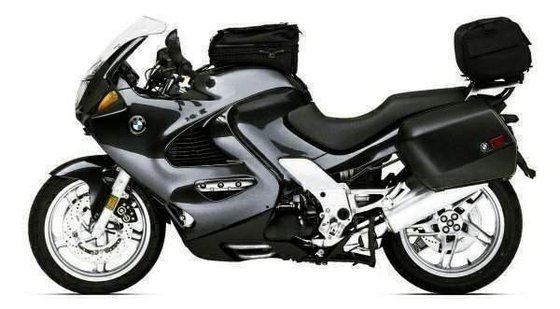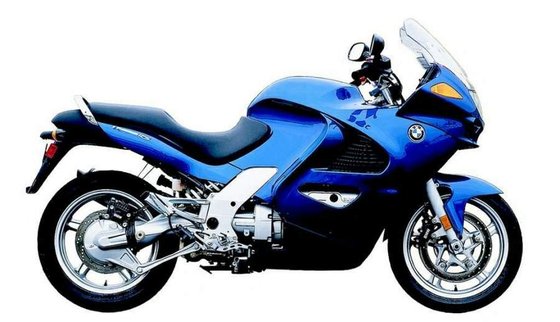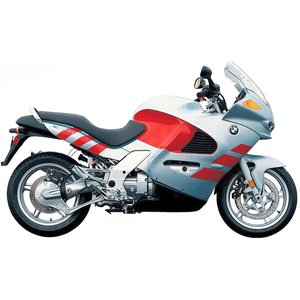BMW K 1200 RS (2001 – 2005): A Sport Tourer with Teutonic Tenacity

Introduction
The BMW K 1200 RS is a motorcycle that defies easy categorization. Built during an era when sport-touring machines were either softened sportbikes or hardened cruisers, this Bavarian brute carved its own niche. Produced from 2001 to 2005, it combined BMW’s engineering pragmatism with a surprising appetite for speed. With its inline-four engine, shaft drive, and avant-garde suspension systems, the K 1200 RS remains a fascinating study in balancing performance with practicality. Let’s dissect what makes this bike tick—and why it still resonates with riders today.
Engine & Performance: Precision Meets Power

At the heart of the K 1200 RS lies a 1,171 cc liquid-cooled inline-four engine, producing 130 HP at 8,750 RPM and 118 Nm (87 ft-lbs) of torque at 5,500 RPM. These numbers put it in the same league as early-2000s superbikes, but BMW’s tuning prioritized usability over outright aggression. The powerband is linear, with a satisfying surge above 5,000 RPM that pulls relentlessly to the redline.
The engine’s character is distinctly un-BMW: it’s a high-revving, free-breathing unit that thrives on momentum. Unlike the boxer twins BMW is famous for, this inline-four feels more at home on autobahns than alpine passes. At highway speeds, the K 1200 RS is eerily composed, with vibrations damped by rubber-mounted engine bearings. Shaft drive ensures low maintenance, though purists might miss the tactile feedback of a chain-driven bike.
Acceleration is brisk: 0–100 km/h (62 mph) in 3.3 seconds and a top speed of 246 km/h (153 mph). Fuel consumption averages 6.4 L/100 km (36.9 MPG), though aggressive riding can drop that to 8 L/100 km (29 MPG). The 20.5-liter fuel tank (5.4 US gal) gives a theoretical range of 320 km (200 miles), but reserve fuel is limited to 4 liters (1.06 US gal)—plan your gas stops carefully.
Handling & Ride Experience: Telelever, Paralever, and Confidence
BMW’s chassis innovations shine here. The Telelever front suspension replaces traditional forks with a system that decouples steering from braking forces. The result? Rock-steady stability under hard braking and mid-corner bumps. Up front, 150 mm (5.9 inches) of wheel travel soaks up imperfections, while the rear Paralever single-sided swingarm (with 115 mm/4.5 inches of travel) keeps the bike planted during aggressive cornering.
Weighing 285 kg (628 lbs) wet, the K 1200 RS isn’t light, but it hides its mass well. Steering is deliberate at low speeds—thanks partly to the steering damper—but becomes laser-precise once you’re moving. The 120/70-ZR17 front and 170/60-ZR17 rear tires (upgraded to 180/55-ZR17 in later years) offer ample grip, and the bike’s geometry (27.3° rake, 124 mm/4.9 inches of trail) strikes a balance between agility and straight-line stability.
Braking is handled by dual 320 mm front discs with 4-piston calipers and a single 285 mm rear disc. ABS was optional but divisive; testers noted it felt intrusive during hard stops. Still, the system works seamlessly in wet conditions.
Comfort & Ergonomics: A Mixed Bag
Here’s where opinions split. The K 1200 RS’s riding position leans sporty, with a low 770 mm (30.3-inch) seat and rearset pegs that force a slight knee bend. Taller riders (or those with aging hips) might find the posture cramped on long rides. The handlebars are a stretch, requiring a forward lean that strains shoulders and wrists. BMW offered accessory risers and peg lowering kits, but these shouldn’t be necessary on a bike designed for touring.
Wind protection is adequate but not exceptional. The fairing directs airflow over the rider’s torso, though buffeting at speeds above 160 km/h (100 mph) can fatigue the neck. The saddle is firm yet supportive—good for 2–3 hours before needing a stretch.
Storage? The optional hard saddlebags are a bright spot. They’re roomy, easy to detach, and don’t require fiddling with keys mid-ride. Compare that to the Honda ST1100’s finicky latches, and the BMW feels refreshingly user-friendly.
Competition: How Does It Stack Up?
In the early 2000s, the sport-touring segment was crowded with worthy rivals:
- Honda ST1100: The anti-K 1200 RS. Honda’s V4-powered tourer prioritized comfort and reliability over excitement. With 98 HP, softer suspension, and upright ergonomics, it was better suited for cross-country slogs. But its anemic top-end and vanilla personality left enthusiasts cold.
- Triumph Trophy 1200: A triple-cylinder alternative with British charm. Lighter and more agile than the BMW, but plagued by questionable build quality and limited dealer support.
- Kawasaki ZZR1200: A hyper-tourer with 160 HP and a backbone frame. Faster in a straight line but less refined in the corners.
The BMW carved out a niche by offering sportbike thrills with touring practicality. It wasn’t as plush as the ST1100 or as raw as the ZZR, but it struck a compelling middle ground—for riders willing to tolerate its quirks.
Maintenance: Keeping the Beast Alive
Ownership costs are par for the BMW course—higher than Japanese bikes but manageable with diligence:
- Oil Changes: Use SAE 15W-50 synthetic (3.5 liters with filter). Interval: Every 10,000 km (6,200 miles).
- Valve Adjustments: Check every 20,000 km (12,400 miles). Intake valves: 0.15–0.20 mm (0.006–0.008 in), exhaust: 0.25–0.30 mm (0.010–0.012 in).
- Shaft Drive: Replace 75W-140 GL-5 gear oil every 40,000 km (24,800 miles).
- Tires: BMW spec’d 2.5 bar (36 psi) front, 2.9 bar (42 psi) rear. Stick to these for optimal wear.
- Brakes: Flush DOT 4 fluid every two years. Pad swaps are straightforward, but ABS models require dealer-level tools for bleeding.
Common wear items include the hydraulic clutch master cylinder (prone to leaks) and fuel injectors (clean every 30,000 km/18,600 miles). The single-disc dry clutch is robust but can judder in stop-and-go traffic.
Conclusion: A Contrarian Classic
The BMW K 1200 RS isn’t for everyone. It’s too aggressive for traditional tourers, too heavy for canyon carvers, and too complex for DIY mechanics. Yet, it’s precisely this contrarian nature that makes it memorable. Few bikes from this era blend Autobahn stamina with backroad agility so convincingly.
If you’re shopping for one today, prioritize post-2003 models with revised suspension and ABS. Upgrade the seat, install bar risers, and keep up with maintenance—this BMW rewards those who invest in it. And when the time comes for parts, MOTOPARTS.store has you covered, from NGK spark plugs (DCPR7EIX) to Telelever seals.
The K 1200 RS is a reminder that sport-touring doesn’t have to be boring. It’s a bike that demands engagement—and repays it with miles of grins.
Specifications sheet
| Engine | |
|---|---|
| Stroke: | Four-stroke |
| Max power: | 130 kW | 174.0 hp |
| Max torque: | 118 Nm |
| Fuel system: | Electronic intake pipe injection (BMW Motronic MA 2.4) |
| Max power @: | 8750 rpm |
| Displacement: | 1171 ccm |
| Max torque @: | 5500 rpm |
| Bore x stroke: | 70.5 x 75.0 mm (2.8 x 3.0 in) |
| Configuration: | Inline |
| Cooling system: | Liquid cooled |
| Compression ratio: | 11.5:1 |
| Number of cylinders: | 4 |
| Valves per cylinder: | 4 |
| Dimensions | |
|---|---|
| Wheelbase: | 1555 mm (61.2 in) |
| Dry weight: | 266 |
| Wet weight: | 280 |
| Seat height: | 770-800 mm (30.3-31.5 in) |
| Overall width: | 850 mm (33.5 in) |
| Overall height: | 1200 mm (47.2 in) |
| Overall length: | 2250 mm (88.6 in) |
| Fuel tank capacity: | 20.5 L (5.42 US gal) |
| Drivetrain | |
|---|---|
| Clutch: | Single-disc dry clutch, hydraulically operated |
| Final drive: | shaft |
| Gear ratios: | 1st 2.045, 2nd 1.600, 3rd 1.267, 4th 1.038, 5th 0.900, 6th 0.829:1 |
| Transmission: | 6-speed |
| Maintenance | |
|---|---|
| Engine oil: | 15W50 |
| Brake fluid: | DOT 4 |
| Gearbox oil: | 600 ml 75W-140 GL-5 |
| Spark plugs: | NGK DCPR7E or NGK DCPR7EIX |
| Spark plug gap: | 0.8 |
| Final drive oil: | 230 ml 75W-140 GL-5 |
| Coolant capacity: | 3.1 |
| Forks oil capacity: | 0.94 |
| Engine oil capacity: | 3.5 |
| Engine oil change interval: | Every 5000 km or 2 years |
| Valve clearance (intake, cold): | 0.15–0.20 mm |
| Valve clearance (exhaust, cold): | 0.25–0.30 mm |
| Recommended tire pressure (rear): | 2.9 bar (42 psi) |
| Recommended tire pressure (front): | 2.5 bar (36 psi) |
| Chassis and Suspension | |
|---|---|
| Frame: | Aluminum twin-spar bridging frame (vibration-decoupled engine) |
| Rear tire: | 170/60-z-17 |
| Front tire: | 120/70-z-17 |
| Rear brakes: | Single 285 mm disc, 2-piston caliper (ABS optional) |
| Front brakes: | Dual 320 mm discs, 4-piston calipers (ABS optional) |
| Rear suspension: | BMW Paralever single-sided swingarm, adjustable preload and rebound damping |
| Front suspension: | BMW Telelever, 35 mm stanchion, central strut |
| Rear wheel travel: | 150 mm (5.9 in) |
| Front wheel travel: | 115 mm (4.5 in) |



















